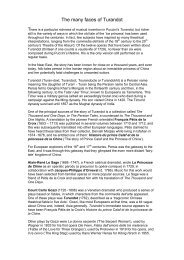NEF-Southampton-Positive-Money-ICB-Submission
NEF-Southampton-Positive-Money-ICB-Submission
NEF-Southampton-Positive-Money-ICB-Submission
Create successful ePaper yourself
Turn your PDF publications into a flip-book with our unique Google optimized e-Paper software.
educing the income and purchasing power of the very people who rescued the economy by borrowing when<br />
interest rates were low.<br />
In contrast, full-‐reserve banking offers the Bank of England and the Monetary Policy CommiOee a way of<br />
directly increasing or decreasing the money supply, and therefore avoids this ‘manic-‐depressive’<br />
management of the economy. It also avoids the need to ship interest rates that affect every exisGng borrower<br />
simply to influence the small group of people who are considering increasing their borrowing at any<br />
parGcular moment in Gme. Under full-‐reserve banking, interest rates can be set by supply and demand<br />
through the markets, with the banks acGng as intermediaries between savers and borrowers.<br />
Re-‐DistribuPon Of Wealth Upwards & Inwards<br />
Because the enGre money supply is created as a debt by commercial banks, in effect interest must be paid to<br />
the banks on every single pound of bank deposits that exists in the economy. A part of this interest is<br />
redistributed back to depositors via interest on savings accounts, etc., but by far the bulk of it is distributed to<br />
the workers of the banks, via salaries and bonuses. This creates three re-‐distribuGon effects:<br />
1. From the Poor to the Rich:<br />
All money is created as debt by the banking system. This ships the ‘baseline’ of poverty down to zero<br />
or negaGve, rather than a low but posiGve bank balance. Because it is those on below-‐average<br />
incomes that end up with much of the debt, they end up paying interest to the banking sector, in<br />
effect meaning that the poor subsidise the middle class or rich.<br />
2. From the ‘Real’ Economy to the Financial Sector<br />
Businesses are also in a similar situaGon. The ‘real’ (non-‐financial), producGve economy needs money<br />
to funcGon, but because all money is created as debt, that sector will also end up paying interest to<br />
the banks. This means that real-‐economy businesses – shops, offices, factories, etc. – end up<br />
subsidising the banking sector.<br />
3. From the Rest of the UK to the City of London and the South East<br />
Because this debt-‐based system returns money to the banking sector, and the bulk of banking sector<br />
salary payments are concentrated within the City of London, this means that there is a transfer of<br />
income from the rest of the UK to the City of London and the South-‐East.<br />
All of these ‘re-‐distribuGon effects’ are inherent to the system and will conGnue year aper year as long as the<br />
money supply is issued by commercial banks as debt, via fracGonal reserve banking. Further research needs<br />
to be done, but it is very possible that the ‘upwards-‐and-‐inwards’ redistribuGon of income caused by this<br />
system of issuing money cancels out any downwards-‐and-‐outwards redistribuGon of income through the<br />
welfare state. Looked at another way, the welfare state may only be necessary because of the design of the<br />
banking system, and could be significantly scaled back if the method of creaGng money was reformed. This<br />
should offer a significant opportunity to improve the fiscal posiGon of the government.<br />
The Need for Deposit Insurance<br />
Under fracGonal reserve banking, a bank will never have sufficient money at any one Gme to repay all its<br />
demand liabiliGes (instant access accounts) simultaneously. This means that a ‘run on the bank’ can very<br />
23



